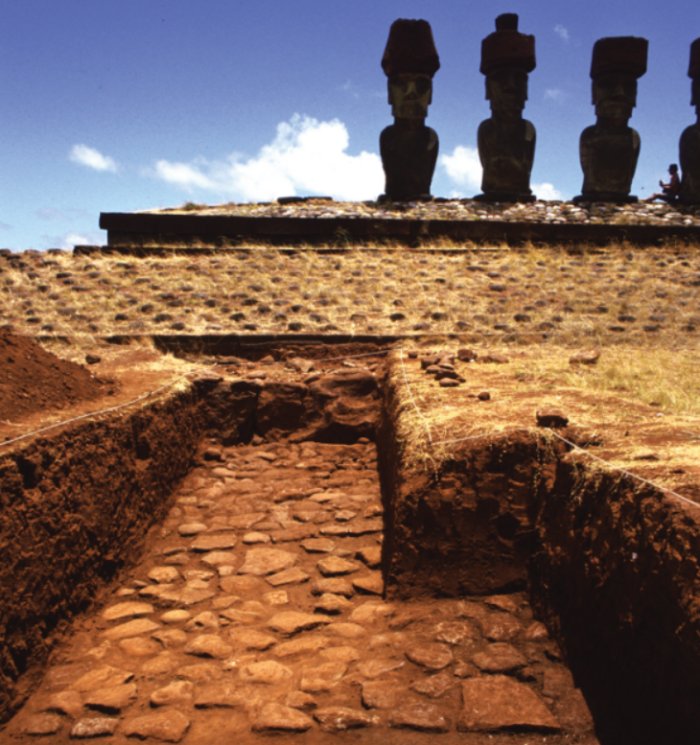Conny Waters – AncientPages.com – The mythical Easter Island (or Rapa Nui), located in the Pacific Ocean, over 3,500 kilometers off the coast of Chile, is one of the most mysterious and remote places in the world.
The island carries a history that is as fascinating as it is enigmatic. Despite its remoteness, Easter Island is not as isolated as we thought.
Archaeologists have conducted a thorough analysis of ritual spaces and monumental structures throughout Polynesia, thereby challenging the prevailing idea that Rapa Nui (Easter Island) evolved in isolation after its initial settlement.
The initial settlers of Polynesia settled the islands, migrating from west to east. They swiftly expanded their presence from the islands of Tonga and Samoa, traversing the vast ocean to reach central East Polynesia. From this central point, they continued their exploration and settlement into far-flung territories including Hawai’i, Rapa Nui, and Aotearoa/New Zealand.
Following the initial colonization, it was believed that the islands of East Polynesia, especially the distant Rapa Nui, remained isolated from the broader Pacific region. Nevertheless, despite their geographical remoteness, similar ritual practices and monumental structures have been documented throughout East Polynesia.
The so-called ‘marae’ can be one example. These rectangular clearings served as communal ritual spaces, and in specific locations, they continue to hold sacred significance. Over time, these spaces evolved differently across various islands. On Rapa Nui, for instance, the renowned moai sculptures were erected and positioned on the ritual temple platforms within marae.
Early ritual structure with pavement and platform at Ahu Nau Nau, Anakena, on Rapa Nui. Above it is the rebuilt elaborated ahu with moai statues (photograph by A. Skjölsvold). Source
To re-evaluate the dissemination and evolution of ritual expression throughout the region, Professors Paul Wallin and Helene Martinsson-Wallin of Uppsala University analyzed archaeological data, including radiocarbon dating, from various settlements, ritual spaces, and monuments across East Polynesia.
The authors explain that while the migration from West Polynesian regions like Tonga and Samoa to East Polynesia is widely accepted, they question the traditional view of a straightforward west-to-east colonization pattern in East Polynesia. Additionally, they challenge the notion that Rapa Nui was colonized just once in history and subsequently developed in complete isolation.
In their study, the authors identified three phases of ritual activity in East Polynesia. The first phase corresponds to the west-to-east expansion, characterized by rituals centered on practices such as burials and feasting. These activities were marked by the presence of stone uprights (c. AD 1000–1300) at various sites. Stone uprights are the earliest and most basic material manifestation of ritual space in Polynesia.
Marae with ahu on Mo’orea, Windward Society Islands (photograph by P. Wallin). Source
The development of these rituals was facilitated through ongoing interactions within established networks.
During the second phase, a more distinct emergence of ritual practices occurred with the construction of marae. Radiocarbon dating indicates that this concept of making ritual sites more prominent began on Rapa Nui. From there, it spread westward into central East Polynesia via established exchange networks.
Finally, the third phase was characterized by increased isolation, resulting in changes linked to the society’s internal cultural development. As hierarchical social structures developed independently in Rapa Nui, Tahiti, Hawai’i etc., large, monumental structures were built to demonstrate power.
Professor Wallin emphasizes that the discovery that C-14 dating reveals an initial west-to-east spread of ritual ideas is significant.
It’s equally intriguing to note that the complex, unified ritual spaces, known as marae, show earlier dates in the east.
In summary, although the findings do not challenge the idea that Polynesia was settled from west to east, they reveal that subsequent ritual developments were significantly more complex than previously believed. This suggests that interaction networks between the islands were dynamic and, importantly, new ideas were also transmitted from east to west.
“This paper challenges commonly accepted ideas about the movement and development of ritual temple sites in East Polynesia”, adds Professor Wallin.
“The findings suggest a more complex pattern than previously thought. Initially, it has been shown that ritual ideas spread from west to east. Later, more elaborate temple structures developed on Easter Island, which then influenced other parts of East Polynesia in an east-to-west movement.”
Written by Conny Waters – AncientPages.com Staff Writer




